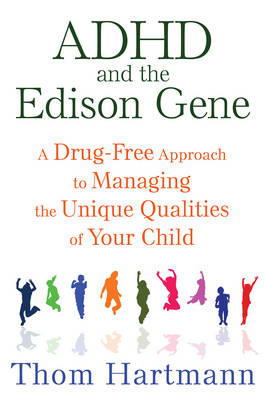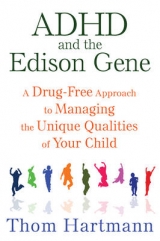ADHD and the Edison Gene
Park Street Press,U.S. (Verlag)
978-1-62055-506-4 (ISBN)
In ADHD and the Edison Gene, Thom Hartmann shows that the creativity, impulsiveness, risk taking, distractibility, and novelty seeking that are characteristic of Attention Deficit Hyperactivity Disorder (ADHD) are not signs of a disorder at all but instead are components of a highly adaptive skill set utilized by our hunting and gathering ancestors. These characteristics have been critical to the survival and development of our modern civilization and will be vital as humanity faces new challenges in the future.
Hartmann, creator of the "hunter versus farmer" theory of ADHD, examines the differences in neurology between people with ADHD and those without, sharing recent discoveries that confirm the existence of an ADHD gene and the global catastrophe 40,000 years ago that triggered its development. He cites examples of significant innovators with ADHD traits, such as Ben Franklin and Thomas Edison, and argues that the children who possess the ADHD gene have neurology that is wired to give them brilliant success as artists, innovators, inventors, explorers, and entrepreneurs.
Emphasizing the role that parents and teachers can play in harnessing the advantages of ADHD, he shares the story of how Edison was expelled from school for ADHD-related behavior and luckily his mother understood how to salvage his self-esteem and prepare him for a lifetime of success. Offering concrete strategies for nurturing, educating, and helping these children reach their full potential, Hartmann shows that rather than being "problems" such children are a vital gift to our society and the world.
Thom Hartmann is a progressive nationally and internationally syndicated talkshow host and an award-winning New York Times bestselling author of 24 books, including Attention Deficit Disorder: A Different Perception and The Last Hours of Ancient Sunlight, which inspired Leonardo DiCaprio’s film The 11th Hour. A former psychotherapist and founder of the Hunter School, a residential and day school for children with ADHD, he lives in Washington, D.C.
Foreword by Lucy Jo Palladino, Ph.D.
Acknowledgments
Introduction: A New View for Our Children
Genetics and Differences
1993: The Hunter Gene
Distractibility
Impulsivity
Risk-Taking
Where Have All the Hunters Gone?
Indigenous Hunters Today
The Agricultural Revolution
Our Society’s Hunters
The Edison Gene
The Crisis-Survival Gene
Hunters Before the Holocene
Adapted to Adversity and Change
Part 1
The Past
1 The World of the Edison-Gene Child
The Ancient World
The Salt Pump
The Great Ice Age
Heated by the Great Conveyor Belt
2 The Dawn of Civilization
What Made Us Human?
The Bacteria That Took Over the World
The Human Bottleneck
Before the Bottleneck
3 Three Ways Humans Were Killed Off by Weather
Warming by the Sun
Vulcan’s Hammer
Survivors: AIDS
Chimps and the Black Plague
Creativity Saves the Day
ADHD and Creativity
The Beads: Clue to the First Edisons
Part 2
The Present
4 Anatomy of a Diagnosis
How Edison-Gene Children Are Different
Are They Disordered?
Anthropology Meets Psychology • From Hunters to Inventors
5 The Mystery of Novelty-Seeking Behavior
The “Novelty Gene”
The Novelty Gene and ADHD
6 Genes Move Around and Turn On and Off
The Genetics of Behavior
Turning on Genes
Codominant Genes
Turning on Edison Characteristics
7 Other Genes and Influences
Neurotransmitters and Personality Characteristics
The Reasons for Genetic Variations
Culture and Genes
8 Scientists Find the “Adaptive” Edison Gene
But Some Say It’s a Disease
Is It a Disorder?
Novelty Seeking
9 The ADHD Gene and the Dawn of Human Civilization
The Time Machine
The News Hits the Streets
The Edison
Gene and Democracy
10 Brain Development and the Edison-Gene Child
Sense of Self
A Process that Mirrors Evolution
The Reptilian Brain
The Limbic Brain
The “New” Brain
The Unique Prefrontal Brain
The Brain Develops After Birth, Too
The First Pruning of the Brain
The Impact of Stress
The Brain in the Birth Period
The Brain in the Toddler Period
The Brain in the Early Childhood Period
The Brain in the Teenage Period
The Brain in the Early Adult Years
Adult Memory of the Stages of Brain Development
Intuition versus Information
The Loss of Intuition
The Tragedy of Lost Potential
Invasion of the Lizard People?
Are We Stuck in a Loop?
Triggering Events
Raising Fully Human Children
Schools May Be the Key
School as Torture
Condemnation
School as Work
Comorbidities
Applying Comorbidities to Edison-Gene Children
Breaking the Loop
Offering a New Story
11 The Edison Gene, Drugs, Exercise, and Nutrition
Nutritional Deficiencies Are Rampant
Environmental Toxins
Nutriceuticals
Yerba Maté: Nature’s Ritalin
Drugs for Edison-Gene Children
Medications Bite Back
Burning Out Brain Cells?
Do Drugs Help Over the Long Term?
The Loss of Play
EEG Neurofeedback
Exercise: The Optimal “Treatment”?
12 Providing Discipline and Structure for the Edison-Gene Child
Nurturing the Hunters
Reward/Punishment versus Inclusion/Interdependence
Separating Person from Behavior
Break the Pattern with a Positive Message
Watch for Islands of Success
The Importance of Mastery
Turn Off the Television
13 Alfred Adler’s Principles for Raising Children
Promote Mutual Respect
Encourage
Foster Security
Avoid reward and Punishment
Use Natural and Logical Consequences
Act Instead of Talk in Conflict Situations
Use Withdrawal as a Counteraction
Withdraw from the Provocation, Not from the Child
Don’t Interfere in Children’s Fights
Fighting Requires Cooperation
Take Time to Teach Essential Skills and Habits
Never Do for a Child What He Can Do for Himself
Don’t Overprotect
Avoid Being Overly Responsible
Distinguish between Positive and Negative Attention
Understand the Child’s Goal
A Habit Is Maintained if It Achieves Its Purpose
Minimize Mistakes
Try a Family Council and Have Fun Together
The Edison-Gene Family
14 Educating the Edison-Gene Child
Learned Helplessness
Reframing Identity = Success in Learning
Government Studies Pronounce on Medication
They Ignored the Environment
The Study Proved Ritalin Doesn’t Improve Learning
But It Makes the Teachers Happy
Lighting a Fire for Learning
Education and Testing Corporations
How Modern Education
Came About
German Schools Come to America
American Education and the Catholic Problem
Backlash Against the Authoritarian Model of Public Education
Maria Montessori
Rudolf Steiner
Free and Alternative Schools
Homeschooling and Internet Schooling
But What About Socialization?
Why Homeschooling Works for Edison-Gene Children
The Edison Gene through the College Years
Find a Mentor or a Coach
15 Edison-Gene Girls and Women
Be a Good Girl
Cinderella in a Hostile World
Cultural Barriers
Cultural Programming and Expectations
Healing the Wounds
Spirituality and the Edison-Gene Child
Edison-Gene Mystics
The Hunter’s Reality
The World of the Hunter’s Dreams
Dreaming with the Natives
Learning to Know
Understanding the Real World
Wild People and Tame People
The Loss of True Wisdom
When Access to Personal Spirituality Is Lost
Part 3
The Future
17 How Edison-Gene Children May Change the World
Glimmers of How Culture Works
What Causes Culture?
The Biology of Culture
Primal Human Cultures
Cultural and Genetic Selection
18 Is Human Evolution Finally Over?
As Good As It Gets
We’re Going Downhill
It’s the Fault of Those People with ADHD!
Are We Standing Still? Distant Bottleneck Events
19 One Generation to Save the World
Climate Flip-Flops to the Next Ice Age
A Global-Warming Bottleneck
Afterword: Yesterday’s Child by Janie Bowman
Notes
Index
| Erscheint lt. Verlag | 5.11.2015 |
|---|---|
| Zusatzinfo | 3 b&w illustrations |
| Verlagsort | Rochester |
| Sprache | englisch |
| Maße | 152 x 229 mm |
| Gewicht | 338 g |
| Themenwelt | Sachbuch/Ratgeber ► Gesundheit / Leben / Psychologie ► Krankheiten / Heilverfahren |
| Sachbuch/Ratgeber ► Gesundheit / Leben / Psychologie ► Schwangerschaft / Geburt | |
| Geisteswissenschaften ► Psychologie ► Persönlichkeitsstörungen | |
| Medizin / Pharmazie ► Medizinische Fachgebiete ► Pädiatrie | |
| Medizin / Pharmazie ► Medizinische Fachgebiete ► Psychiatrie / Psychotherapie | |
| ISBN-10 | 1-62055-506-9 / 1620555069 |
| ISBN-13 | 978-1-62055-506-4 / 9781620555064 |
| Zustand | Neuware |
| Haben Sie eine Frage zum Produkt? |
aus dem Bereich




